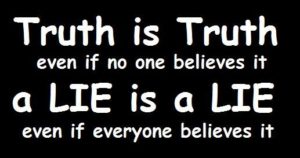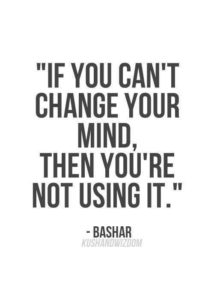We spend a huge amount of time and effort trying to change the behavior of others. Changing the behavior of others is the goal of protesters, teachers, parents, wives, girlfriends, negotiations, advertising, marketing, and the list goes on. There are literally tens of thousands of books on the topic. Millions of people are involved. Fortunes made. Fortunes lost. Yet at the core, the answer is relatively simple. How to change a person’s behavior is the topic of this post.
The scene is 1965 at Fairview Junior High School in 8th grade Social Studies. I heard about this behavior modification experiment. Three friends and I did the experiment in class. Every time the teacher got closer to the map on the side of the room, we would pay close attention to him and nod in an affirming way. Any time he was further from the map, we totally ignored him. It only took like 15 – 20 minutes to get him standing firmly in front of the map.
It was years later while getting my BS in Psychology before I understood the experiment was not just about getting a teacher to move 10 feet to the left. Often overlooked is the student’s behavior was also modified. From the teacher’s point of view, all he had to do to get four students to pay attention was to move 10 feet to the left. He taught, we learned. We thought we were playing a joke on a teacher; maybe the joke was really on the four of us.
This was Fairview Junior High School in Roseville, MN. Now it is a community center. Middle school was 7th, 8th and 9th grades. As I recall our Social Studies classroom was on the first floor, right corner.

Behavior modification is straightforward. When the “target” does something you like, give them positive feedback and / or reduce the negative feedback. To reduce a behavior, add a negative consequence and or take away something they like. The trick is to establish a relationship between the feedback and the behavior desired. To make the behavior more permanent, randomly spread out the positive or negative feedback. It takes longer but the resulting behavior change will last longer.
A little less straightforward is the reality the target is also giving you positive and negative feedback. Feedback is a two-way street. We learn from each other. You might think you taught the rat to press the lever for food. However, from the rat’s point of view, it taught you to feed it when it pressed the lever.

A contemporary example of this principle is many apps on a smart phone. The goal from the app designer’s point of view is to train us to spend as much time as possible in the app. The app gives us positive reinforcements when we stay in the app and negative reinforcements when we leave. At first, they make it easy and fun (positive reinforcement). Just when you are getting the hang of it and smiling, they make it time out (negative reinforcement). You get the opportunity to avoid the negative by buying more time (coins, lives, etc.) However, even if you do not make a purchase you just have to wait for a prescribed time for the opportunity to spend more time in the app. When you spend more time, you view more ads. I am on level 223 in one of my games. My ad views or buying more lives (I never do this) pays the developers of the game. The weird thing is that I am fully aware that the apps are training me to the end of increasing their profits. However, I still enjoy using the app (game) and enjoyment was my goal in the first place.
If only real life were that simple. In reality, positive or negative are in the eye of the beholder. If the teacher was very shy, four kids staring and nodding at him might have made him uncomfortable and actually less likely to stand by the flag. There were 25 kids in the room each giving the instructor feedback. Maybe when the teacher stood by the flag, it would have caused some of the kids give the teacher negative feedback because they had to turn their heads awkwardly. In the real world, feedback comes from many sources: real and some imagined. As I recall in junior high, we often wondered if a person of the opposite sex was giving us “the look” and then spent hours on the phone with our friends to figure out if the look was positive or negative feedback.

The cause of behavior is complex and influenced by all sorts of factors, some of which are positive and negative reinforcements. Behavior does not happen in the vacuum. Often, circumstances beyond our control are at work. There are tradeoffs and bad choices made. It would be wrong to think that we can change the course of human behavior by nodding a couple times in an eighth-grade classroom. However, it would also be wrong to ignore the powerful effect that providing positive and or negative reinforcement can have on others and ourselves.
In the “move the teacher experiment”, the goal might be to modify the behavior of the teacher but the process will influence the behavior of those trying to cause the change. The teacher had a reputation for being old, cranky, overly serious and boring. To pull off the experiment, we had to carefully watch him to know when to give him positive feedback (nod approvingly) and when to give him negative feedback (ignore him). Do you nod once or several times in a row. Do you look away or just look blank. It did not take long to move him to the flag but it was intense while we were doing it. The process taught us a big lesson. The teacher cared if we paid attention; he did not want to be ignored and enjoyed getting positive feedback. I could not have verbalized it at the time but the experiment taught me the teacher was just trying to teach us about social studies the best he could.
Making a teacher unknowingly stand by the flag is not ethical. Pretending to be interested or pretending to ignore the teacher was to be dishonest. Having a laugh at someone else’s expense is not nice. Looking back, it was not one of my proud moments. We could have really embarrassed the teacher and probably would have been subject to the wrath of the teacher, principle and maybe our parents. Looking back, we could have hurt the self-confidence and credibility of the teacher. He was not one to take a joke.
On the other hand, engaged with what the teacher was saying and providing appropriate honest feedback could have helped him not to be so boring. Nod and pay attention when he presents in a more interesting style and give a negative impression when he gets boring. With about the same amount of effort we could have made the class better for us and helped future students.
Again, the trick is to make the connection between the behavior you want modified and the feedback you are providing. Proximity and timing matter. However, often the best method to make the connection is to make the connection as straightforward as possible. What exactly are you protesting? Make it known. Exactly what behavior do you want to be different? Make it known. The connection between the behavior of the target and the feedback you give are often not as connected as you may think. The target might well have other motivations. Give honest feedback but remember there were 25 other students in the room.
Paying attention and giving honest feedback is a magic formula for many aspects of life: successful learning, relationships, jobs, socializing, negotiations, etc.
If we want to help our leaders be better leaders, or kids to be better kids, or customers to buy a product, the best thing to do is to pay attention to their actions and give them honest positive and negative feedback tied to the action we want them to perform. Forget the hyperbole. Forget the outrageous statements. Pay attention to the person (know your customer). Give them verbal and non-verbal feedback directly related to the behavior in question. Repeat often at first then less frequently. Remember that you may be training them but in the bargain, you modify your own behavior. You teach the target and the target teaches you.
For example, if a leader was a narcissist. Trying to change his behavior with a large protest, where he is the center of attention, might well reinforce his self-image of how important he is. If the goal were about changing the actions taken on a particular issue, a strategy of focusing the protest on the issue, rather than on the narcissist, might make sense. Another strategy might be to focus on someone other than the narcissist (Cabinet member). However, a word of caution, narcissists are not very empathetic. So do not expect them to feel sorry for a subordinate.
Be engaged, straightforward and honest. The real secret of the “move the teacher experiment” was the change in behavior of the four students. The teacher was doing what it took to make us pay attention. His goal had not changed. The students were showing the teacher what it would take to make us pay attention. The experiment actually taught us the teacher cared enough to be willing to move 10 feet to the left if it would help us to pay attention.

WARNING: People can fake “engaged, straightforward and honest”. Fraud is a bad thing for many reasons but here is another one. Remember that both parties get their behavior modified. In the case of fraud, the target is an innocent, but the fraud becomes a distrusted, guilty person.
FYI
Reinforcement = increasing a behavior
- Positive reinforcement = When a favorable outcome, event, or reward occurs after an action, that particular response or behavior will be strengthened.
- Negative reinforcement = a response or behavior is strengthened by stopping, removing or avoiding a negative outcome or aversive stimulus.
Punishment = reducing a behavior
- Positive punishment = adding a negative consequence after an undesired behavior is emitted to decrease future responses
- negative punishment = taking away a certain desired item after the undesired behavior happens in order to decrease future responses
Remember: One of the best ways to change behavior is to create an honest feedback cycle for the target. Engage with the target. Make sure the target understands the connection between the desired behavior and the feedback by being straightforward. Be honest with yourself and the target. You do not want to train yourself to be a fraud.




























